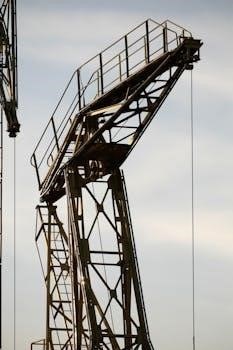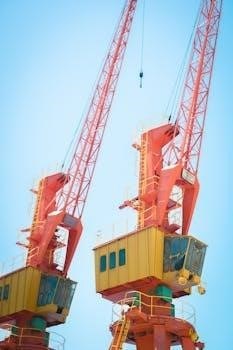Hoist manuals are essential for safe and efficient operation. They provide crucial information on proper usage‚ maintenance‚ and safety protocols. These manuals guide users in understanding their hoist’s specific features and limitations. Regular consultation of the manual ensures longevity and reduces accident risks.
Purpose of Hoist Manuals
The primary purpose of hoist manuals is to provide comprehensive guidance for the safe and effective operation‚ maintenance‚ and inspection of hoists. These manuals detail specific procedures‚ safety precautions‚ and recommended maintenance schedules‚ ensuring that users adhere to industry standards and regulations‚ such as OSHA and LOLER. Furthermore‚ they outline the proper techniques for lifting various loads‚ preventing accidents‚ and ensuring the longevity of the equipment. Manuals also serve as a reference for troubleshooting common issues and identifying potential hazards. They facilitate operator training‚ ensuring competency in using the hoist and its safety features. Ultimately‚ hoist manuals promote workplace safety and equipment reliability‚ helping to minimize risks and maximize performance.

Hoist Operation Procedures
Proper hoist operation involves following specific procedures to ensure safety and efficiency. This includes pre-operation checks‚ adherence to load limits‚ and smooth control movements. Training is crucial.
Standard Operating Procedure (SOP) for Hoists
A Standard Operating Procedure (SOP) for hoists is crucial for consistent and safe operation. It outlines the specific steps to be followed before‚ during‚ and after each hoist use. The SOP should include detailed instructions on pre-operation checks‚ such as verifying hook latches and ensuring no obstructions exist. It must also define the proper techniques for lifting‚ lowering‚ and moving loads‚ emphasizing smooth and controlled movements. Furthermore‚ the SOP must clearly state the load limits and the consequences of exceeding them‚ and provide clear guidance on emergency procedures and reporting of any incidents. It’s essential that all operators are thoroughly trained on the SOP.
Pre-Operation Checks
Prior to operating any hoist‚ thorough pre-operation checks are mandatory to ensure safety and prevent accidents. These checks involve a visual inspection of the hoist‚ including the chains or cables‚ hooks‚ and any other critical components. It is essential to verify that hook latches are closed and functioning correctly‚ and that there are no signs of wear‚ damage‚ or corrosion. Operators should confirm that all controls are working smoothly and that the hoist travels in the intended direction. The area around the hoist should also be checked to ensure no obstructions are present. These pre-operation checks are vital for maintaining a safe working environment and preventing equipment failure.
Safe Lifting Practices
Safe lifting practices are crucial for preventing accidents and ensuring the well-being of personnel. Always verify the hoist’s load capacity and ensure it is not exceeded. The load must be properly secured to the hook‚ avoiding any swinging or jerking motions. Remove slack from the slings and ropes before lifting‚ and never allow the load to pass over anyone. Maintain a firm footing when operating the hoist‚ and use smooth‚ controlled movements to avoid abrupt changes. Clear communication among personnel is vital‚ and the lifting area should be free from obstructions. Always adhere to established safety standards and guidelines for safe lifting operations.
Hoist Maintenance and Inspection
Regular hoist maintenance and inspection are vital for safe operation. This includes scheduled checks‚ lubrication‚ and part replacement. Proper upkeep extends the hoist’s lifespan and prevents failures. Record keeping is crucial.
Regular Maintenance Schedule
A consistent maintenance schedule is essential for hoist longevity and safety. This schedule should include daily‚ weekly‚ and monthly checks. Daily inspections involve looking for loose bolts‚ unusual noises‚ and frayed cables. Weekly checks might include lubricating moving parts and testing limit switches. Monthly maintenance should involve a more thorough examination of motors‚ wiring‚ and controls. It’s crucial to adhere to the manufacturer’s recommendations for specific maintenance tasks and intervals. Regular maintenance helps prevent unexpected failures and ensures the hoist operates safely and efficiently. Following the schedule is paramount for maintaining safety and compliance.
Daily Inspections and Checks
Daily inspections are crucial for ensuring the safe operation of a hoist. Before each use‚ check for any visible signs of wear or damage. This includes inspecting cables‚ chains‚ and hooks for fraying‚ cracks‚ or deformations. Ensure that hook latches are closed and functioning properly. Listen for any unusual noises during operation‚ which could indicate a problem. Verify that the hoist travels in the correct direction as indicated on the controls. Also‚ confirm that all safety devices‚ such as limit switches‚ are working. These checks are vital to prevent accidents and ensure equipment safety. Adhering to daily inspection protocols is paramount for safe operations.
Professional Technician Inspections
Regular inspections by qualified technicians are essential for maintaining hoist safety and reliability. These professionals conduct thorough examinations‚ looking for issues that might be missed during daily checks. They assess the structural integrity‚ mechanical components‚ and electrical systems of the hoist. Technicians also check for compliance with safety regulations like LOLER and OSHA. These inspections include detailed testing of safety features such as overload protection and emergency stop functions. Professional technicians are trained to identify potential problems before they lead to equipment failure or accidents. Their expertise ensures that hoists operate safely and efficiently‚ prolonging their service life. These inspections are crucial for workplace safety.
Lubrication and Cleaning
Proper lubrication and regular cleaning are critical for maintaining a hoist’s performance and extending its lifespan. Lubrication reduces friction between moving parts‚ ensuring smooth operation and preventing wear. Specific lubricants should be used as recommended by the manufacturer. Cleaning removes debris‚ rust‚ and contaminants that can cause stiffness or corrosion. Chains and other components should be thoroughly cleaned and dried before lubrication. Regular cleaning and lubrication prevent breakdowns and ensure the hoist operates efficiently. This routine maintenance also helps identify any early signs of wear or damage. A consistent schedule for lubrication and cleaning is essential for safe and reliable hoist operation. Neglecting these tasks can lead to equipment failure.

Safety and Regulations
Adhering to safety regulations is paramount for hoist operation. Compliance with OSHA and manufacturer guidelines is crucial. LOLER regulations also ensure equipment safety through regular inspections. These measures prevent workplace accidents.
OSHA and Manufacturer Safety Recommendations
Following both OSHA and manufacturer’s safety guidelines is critical for safe hoist operation. OSHA provides general workplace safety standards‚ while manufacturers offer specific instructions for their equipment. These recommendations include proper load limits‚ pre-use inspections‚ and safe operating procedures. Regular review of these guidelines ensures that the hoist is used correctly‚ reducing the risk of accidents and injuries. Proper adherence to these recommendations extends the lifespan of the equipment and maintains a safe working environment. Always consult the hoist’s manual and relevant safety documentation before operation. This diligent approach protects personnel and equipment from potential harm during lifting operations.
LOLER Regulations and Compliance
LOLER‚ or the Lifting Operations and Lifting Equipment Regulations‚ mandates regular inspections and maintenance for hoists. Compliance with LOLER is crucial for ensuring the safety and functionality of lifting equipment. These regulations require thorough examinations by competent personnel at specified intervals‚ typically every six months. Proper documentation of inspections and maintenance is also necessary to demonstrate adherence. Failure to comply with LOLER can lead to legal penalties and increase the risk of accidents. Understanding and implementing LOLER requirements is essential for maintaining a safe work environment. Regular checks‚ thorough documentation‚ and competent personnel are key aspects of LOLER compliance.
Safety Features of Hoists
Modern hoists are equipped with various safety features designed to prevent accidents and ensure safe operation. Overload protection mechanisms prevent lifting beyond the hoist’s rated capacity‚ minimizing the risk of equipment failure. Emergency stop functions allow for immediate halting of operations in critical situations. Limit switches prevent over-travel‚ preventing damage to the hoist and surrounding structures. These features are vital in maintaining a safe working environment. They offer crucial safeguards during lifting operations. Regular checks of these features are essential. Ensuring all safety mechanisms are functioning properly is paramount for preventing injuries and equipment damage. They provide a reliable and safe lifting experience.

Training and Competency
Proper training is crucial for safe hoist operation. Operators must understand safety procedures and emergency protocols. Refresher courses maintain competency and up-to-date knowledge. Consistent training is essential.
Operator Training Programs
Comprehensive operator training programs are vital for ensuring the safe and efficient use of hoists. These programs should cover all aspects of hoist operation‚ including pre-operation checks‚ proper lifting techniques‚ and understanding load limits. Training must also emphasize emergency procedures and responses to potential hazards. Furthermore‚ operators need to be educated on the importance of regular maintenance and inspection protocols‚ as well as the recognition of signs indicating equipment malfunctions. The program should also include practical‚ hands-on experience‚ and should be conducted by qualified instructors. This extensive training ensures that all operators are fully competent‚ reducing the risk of accidents and extending the lifespan of the equipment.
Refresher Courses for Operators
Regular refresher courses are essential for maintaining operator competency and ensuring up-to-date knowledge of safety procedures. These courses serve to reinforce initial training‚ address any new guidelines or regulations‚ and refresh best practices. Refresher training should cover any changes in equipment‚ new safety features‚ and updated maintenance protocols. These courses should also provide opportunities for operators to discuss any challenges they may be facing. This continuous training helps prevent complacency and ensures that operators are always operating the hoist safely. Refresher courses should be conducted by qualified trainers and include hands-on practical sessions to ensure effective learning and application of safety protocols.

Specific Hoist Types
Different hoist types have unique operational and maintenance needs. Understanding these specifics is crucial for safety. Electric‚ hand chain‚ and wire rope hoists each require specialized handling and care.
Electric Cable Hoist Basics
Electric cable hoists are designed to improve lifting performance and safety. Understanding their features is essential for effective operation. Selection should align with specific lifting needs‚ considering load capacity and environmental factors. Proper installation is crucial to ensure safety and prevent failures. Operation requires careful adherence to safety protocols and manufacturer guidelines. Maintenance includes checking motors‚ wiring‚ and controls‚ along with lubricating moving parts. Regular inspections are vital for longevity and accident prevention. Knowing the basics ensures optimal performance and extends the service life of your electric cable hoist‚ minimizing risks and maximizing efficiency.
Hand Chain Hoist Safety
Hand chain hoists require strict adherence to safety protocols for safe operation. Pre-use inspections are crucial to identify potential hazards before lifting. Operators must be trained and familiar with emergency procedures. Adherence to operational protocols is necessary to prevent accidents. Regular maintenance‚ including chain checks and lubrication‚ extends the hoist’s lifespan. Avoid side pulling and ensure a firm footing when operating. Never exceed the hoist’s load limit. Proper rigging techniques are essential to prevent dropped loads. Clear communication among personnel is vital. Understanding these safety guidelines reduces risks and ensures efficient manual lifting operations. Consistent practices improve overall safety.
Wire Rope Hoist Maintenance
Regular maintenance is vital for ensuring the longevity and safe operation of wire rope hoists. This includes frequent checks for wear‚ fraying‚ and damage to the wire rope itself. Lubrication of moving parts must be performed consistently to prevent friction and ensure smooth operation. Inspect rollers and sheaves to ensure they guide the rope smoothly‚ preventing twists. Avoid inducing twists in the rope during installation‚ as this can weaken it. Pay close attention to the hoist’s safety features like limit switches and brakes‚ ensuring they are functioning correctly. A proactive maintenance schedule is key to preventing failures and ensuring safe lifting operations. Record all maintenance tasks.